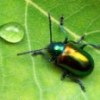As if butterflies weren't flamboyant enough already, it seems that some of them actively impersonate queens.
Queen ants, that is. A report by Francesca Barbero et al in today's issue of Science documents a clever strategy employed by a European butterfly, the Mountain Alcon Blue Maculinea rebeli, to infiltrate nests of Myrmica schencki. The immature stages of the butterfly are parasites of ant colonies, and it seems the secret to their success is acoustic mimicry. The larvae and pupae squeak like queens, eliciting preferential treatment from the workers. Here's the abstract:
Ants dominate terrestrial ecosystems through living in complex societies whose organization is maintained via sophisticated communication systems. The role of acoustics in information exchange may be underestimated. We show that Myrmica schencki queens generate distinctive sounds that elicit increased benevolent responses from workers, reinforcing their supreme social status. Although fiercely defended by workers, ant societies are infiltrated by specialist insects that exploit their resources. Sounds produced by pupae and larvae of the parasitic butterfly Maculinea rebeli mimic those of queen ants more closely than those of workers, enabling them to achieve high status within ant societies. We conclude that acoustical mimicry provides another route for infiltration for ~10,000 species of social parasites that cheat ant societies.
Sounds of the ants and the butterfly are posted at Science News. Â See also commetary by Discover and Not Exactly Rocket Science.
source: Barbero, F. and J.A. Thomas, S. Bonelli, E. Balletto, K. Schönrogge. 2009. Queen ants make distinctive sounds that are mimicked by a butterfly social parasite. Science 323(Feburary 6): 782-785.

Since, I think at least some, Myrmice still mate on the ground I sure hope these caterpillars don't take this mimicking thing to far.
Nature just keeps getting more wonderful, the more we know.
It boggles the mind. So many intricacies out there we know nothing about.
This is not really a very new discovery, is it?
I have read about it previously and David Attenborough even covers it in Life in the Undergrowth.
http://www.youtube.com/watch?v=GCo2uCLXvhk
Here is a short, written version of the story to be found in the Life in the Undergrowth clip I linked above. You might chase it further from here:
http://blog.wired.com/wiredscience/2008/01/butterfly-and-w.html
Yes, Bug Girl, it gets more wonderful. Yes, Huckleberry Days, so many intricacies...
I think this little vignette of co-evolutionary entanglement is better than the richest plot in a who-dunnit.